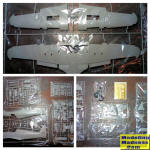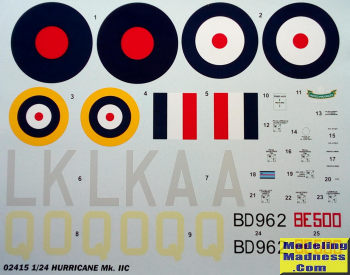
Trumpeter 1/24 Hurricane IIc
| KIT #: | 02415 |
| PRICE: | €55 on offer |
| DECALS: | Two options |
| REVIEWER: | Spiros Pendedekas |
| NOTES: |

| HISTORY |
The Hawker Hurricane is a British single-seat fighter aircraft of the 1930s–40s which was designed and predominantly built by Hawker Aircraft Ltd. for service with the Royal Air Force (RAF). It was overshadowed in the public consciousness by the Supermarine Spitfire's role during the Battle of Britain in 1940, but the Hurricane inflicted 60 percent of the losses sustained by the Luftwaffe in the engagement, and fought in all the major theaters of the Second World War.
It went into production for the Air Ministry In June 1936 and entered squadron service in December 1937. Its manufacture and maintenance was eased by using conventional construction methods so that squadrons could perform many major repairs without external support. The Hurricane was rapidly procured prior to the outbreak of the Second World War in September 1939, when the RAF had 18 Hurricane-equipped squadrons in service. The aircraft was relied on to defend against German aircraft operated by the Luftwaffe, including dogfighting with Messerschmitt Bf 109s in multiple theaters of action.
It was was developed through several versions: bomber-interceptors, fighter-bombers, and ground support aircraft as well as fighters. Versions designed for the Royal Navy known as the Sea Hurricane had modifications enabling operation from ships. Some were converted as catapult-launched convoy escorts. By the end of production in July 1944, 14,487 Hurricanes had been completed in Britain and Canada, with others built in Belgium and Yugoslavia.
The MK IIC version utilized the improved Merlin XX engine with two-speed supercharger. This new engine used a coolant mix of 30 percent glycol and 70 percent water. Pure glycol is flammable, so not only was the new mix safer, but the engine also ran approximately 21 °C (70 °F) cooler, which gave longer engine life and greater reliability.[152] The new engine was longer than the earlier Merlin and so the Hurricane gained a 4.5 in "plug" in front of the cockpit, which made the aircraft slightly more stable due to the slight forward shift in center of gravity. Mk IIC’s were equipped with new and slightly longer propeller spinner, and fully replaced the machine-gun armament with four 20 mm (0.79 in) Hispano Mk II cannons, two per side. Hurricane IIA Series 2 became the Mk IIC in June 1941, using a slightly modified wing. The new wings also included a hardpoint for a 500 or 250 lb (230 or 110 kg) bomb and, later in 1941, fuel tanks. By then performance was inferior to the latest German fighters, and the Hurricane changed to the ground-attack role, sometimes referred to as the Hurribomber. The mark also served as a night fighter and intruder with about three quarters converted to fighter bombers. There were IIC 4,711 built by Hawker between February 1941 and July 1944.
| THE KIT |
 It
was 2007 when Trumpeter came out with their “modern” 1/24 Hurricane kits,
offering the Mk I, -IIC and -IIC Trop versions, followed by the -IID Trop
sometime in 2012. My kit was the standard Mk IIC version, offered at “a price I
couldn’t refuse" from one of my favorite Athens hobby shops. Trumpeter has got
us used to quality boxings, this one being no exception: the kit came in a big,
very sturdy top opening box with a good box art portraying a bird of RAF 3
Squadron.
It
was 2007 when Trumpeter came out with their “modern” 1/24 Hurricane kits,
offering the Mk I, -IIC and -IIC Trop versions, followed by the -IID Trop
sometime in 2012. My kit was the standard Mk IIC version, offered at “a price I
couldn’t refuse" from one of my favorite Athens hobby shops. Trumpeter has got
us used to quality boxings, this one being no exception: the kit came in a big,
very sturdy top opening box with a good box art portraying a bird of RAF 3
Squadron.
Upon opening the box, I was greeted with about 200 light gray styrene pieces,
arranged in 10 sprues of various sizes, most of them individually bagged.
Molding looks first class, with fine engraved details all over. Fabric
representation, a key aspect in every Hurricane kit, is very realistically
rendered. a bazillion of rivets are present all over the metallic external
areas, but they are really beautifully done. No flash is apparent whatsoever. A
PE fret is also provided, containing nice seat belts and cockpit console faces,
among others.
Cockpit looks very well appointed with the distinctive tubular construction
correctly rendered and with nice sidewalls detailing. The instrument panel is
supplied per the usual “Trumpeter” style of an acetate film that has to be
sandwiched between the front and rear covers: whereas a number of modelers do
not like this arrangement, truth is that a good looking instrument panel can
result even from it. The side consoles are provided as PEs, with the starboard
one built up with styrene levers and switches. Seat belts are provided as PE,
looking nice. The PE fret itself looks workable and not too stiff, as some older
Trumpeter PE frets did.
The engine is a mini odel in itself, comprising almost 30 pieces, not counting
the exhausts! The spark plug harnesses are provided as vinyl pieces: they look
great, but I have never tried such an arrangement in practice. Since the engine
represents a Merlin II, not a Merlin XX, the correct version for the MK IIC,
should you wish to display it through open panels, some modifications will be
necessary, in order to bring it to “XX” status. Finally, the engine serves as a
base onto where the exhausts and prop hub are mounted, so, if you decide not to
include it, you must somehow cater for the exhausts and hub mounting.
Landing gear is expectedly very well represented, with the bays featuring a good
amount of the detailing found in the real thing. Gear legs and wheel rims are
also looking good, but, I believe, brake lines should have been molded on or
even separately included: the legs look too plain without brake lines at this
scale. Tires are provided only in vinyl, something that a number of modelers do
not like. Styrene tires (or full wheels) would have optionally been provided.
The cannon bays and the cannons themselves are very detailed, with their access
panels provided separately, should you wish to display them open. Ailerons,
elevators, rudder and flaps are also separate, meaning they can be posed
“dynamically”.
The prop has its blades separately molded, but does not look difficult to put
together. The oil cooler looks well detailed, as do the 3-piece exhausts.
Finally, the clear parts look really nice, clear and crisp.
 Instructions
are well done, coming at the typical Trumpeter booklet style, with the
construction spread in 26 clear steps. A sprue parts list is also given. Two RAF
schemes are provided, a 3 Squadron bird of dark green and dark gray over light
gray, as it stood in 1942 and a 78 Squadron night fighter, belonging to Squadron
leader Sir Denis Smallwood, during 1940-41. Decals look of good quality and
sharply printed, however their “blues” and “reds” are reportedly too bright.
Instructions
are well done, coming at the typical Trumpeter booklet style, with the
construction spread in 26 clear steps. A sprue parts list is also given. Two RAF
schemes are provided, a 3 Squadron bird of dark green and dark gray over light
gray, as it stood in 1942 and a 78 Squadron night fighter, belonging to Squadron
leader Sir Denis Smallwood, during 1940-41. Decals look of good quality and
sharply printed, however their “blues” and “reds” are reportedly too bright.
Instructions typically start with cockpit assembly, followed by engine assembly
. The tail planes are next to be assembled, then construction returns to the
cockpit sidewalls and the trapping of both cockpit and engine between the
fuselage halves, with the tail planes and rudder attachment following.
Construction then moves to the build-up of the main
wheel bays at the inner side of the lower wing half and the gun bays parts at
the two upper wing halves. The guns are next assembled and trapped between the
wings. The next two major steps deal with finalizing the wing, by attaching the
gun bay panels, cannon fairings and barrels, landing and wing tip lights, flaps
and ailerons, with the completed wing next attached to the fuselage.
Landing gear, oil cooler and air intake are next assembled and attached,
followed by the prop, exhausts and transparencies.
| CONCLUSIONS |
Apart from the sole option of vinyl tires, the wrong version engine and the “bright colored” decals (which, after all, are not major issues), this is really an excellent kit of the iconic Mk IIC. General shape looks spot on and overall detail is superb. The big scale and high parts count might be daunting to some, but, truth is that, mutatis mutandis, construction is not that more complicated than the 1/48 Hasegawa one. The kit builds superbly and results can be gorgeous, as Tom Cleaver demonstrated here.
Interestingly, this specific kit version looks to
have every key area right regarding accuracy. Add to the above the fact that the
kit can nowadays (as of 2021) be found at a good fraction of the price it used
to be offered in the past and we have a winner here, the only real “issue” being
to secure a sizeable space “somewhere in the house”, in order to display it!
Happy modeling!
February 2022
Copyright ModelingMadness.com. All rights reserved. No reproduction in part or in whole without express permission.
If you would like your product reviewed fairly and fairly quickly, please contact the editor or see other details in the Note to Contributors.